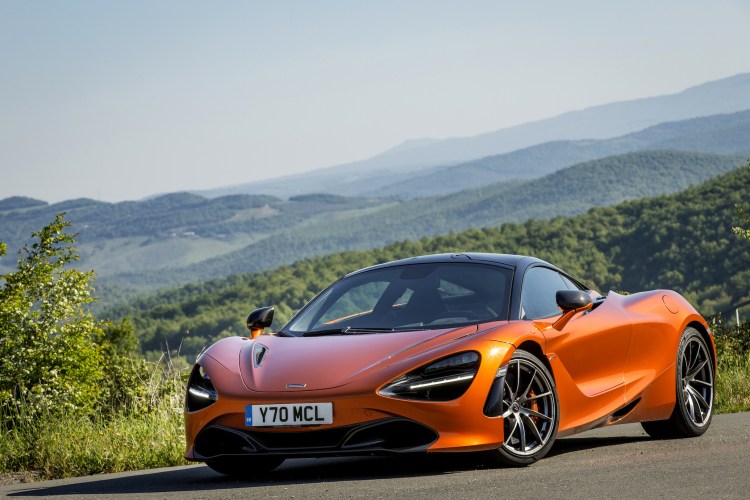LOS ANGELES – McLaren doesn’t make a lot of cars – about 3,300 in 2017 – or a lot of models. But what it makes is magic.
Starting with the Sports Series, rising through the Super Series, and culminating in the Ultimate Series, the McLaren machines are highly intentional, purpose-built vehicles.
They are designed to do one thing well: get around a race track very quickly. The company has its roots in racing, and even today advertises its cars by boasting, “We use Formula 1 technology and expertise to create the most advanced sports cars in the world.”
The trouble is, they do that so well that they don’t do anything else very well at all.
McLaren’s 720S is a marvel of this speed-specific design. Starting with a carbon fiber “monocage” chassis, the engineers at the Woking, England, factory produce a 2,900-pound race car, driven by a 4-liter V-8 engine, that runs like a rocket.
Capable of a top speed of 212 miles per hour, a zero-to-60-mph time of 2.8 seconds and a zero-to-100-mph time of 5.5 seconds, the rear-engine 720S is also equipped with McLaren’s proprietary adaptive suspension system and electro-hydraulic rack and pinion steering, and wears Pirelli P Zero Corsa tires.
So it goes fast in a straight line and then seemingly faster through the turns, making a fast driver feel faster and an amateur feel less inadequate.
This wasn’t my first McLaren. I had liked the 570S. I had really liked the 570GT.
But this was by far the fastest and most powerful English sports car I’d ever driven.
During the week that I had the keys to the 720S, I experienced the Super Series car in a variety of settings. While the McLaren and I did not make it to the track, we did a fair amount of city driving, high-speed motoring and canyon carving.
It was the last that I loved the best. Sitting low, tracking well, the knife-like sports car seemed to find perfect lines through the twisties almost intuitively, without much operator cerebration. I felt the full benefit of the car’s traction control, stability control and seamless gearbox.
Gurgling happily on the downshifts, and then roaring into the straightaways, the 720S’ twin turbo V-8 gave audible voice to its 720 horsepower and 568 pound-feet of torque.
The 720S offers three driving modes – Comfort, Sport and Track – which alter settings in the powertrain, transmission and suspension. In Sport mode, the handling was perfectly dialed in for the Angeles Forest Highway sweepers.
The route to and from the canyons, driving the 5, 210 and 14 freeways, was a less thrilling and less enjoyable experience. The lovely music from the V-8, even at cruising speed, made an imperfect experience out of listening to music or talking on the phone.
More than one person asked me, “Where are you?” when we spoke, and the otherwise quite good Bowers & Wilkins sound system was wasted on speeds above 60 mph.
But it was the city driving that was most problematic, and urban conditions that exaggerated the 720S’ daily driver failings.
The dihedral doors swoop open to reveal a spare interior, again reinforcing this car’s intentions. The seats are minimally adjustable. The visibility is extremely limited. The infotainment and climate control systems both require paging through menus to make adjustments, which requires the driver to spend a lot of time looking at the screen instead of the road.
(I was forewarned, sort of. The person who delivered the car said the infotainment system was “intuitive.” In my experience, this is shorthand for, “You will probably be able to figure it out, with time, but I’m not going to explain it because it’s just too complicated.”)
The rearview camera that appears in that screen helps considerably with backing and parking. So does the essential nose lift function, which will keep the 720S from scraping its chin on driveways.
That’s a $2,510 upgrade on the 720S, and the model I drove had many other options.
The lightweight wheels cost an additional $5,330. The rear “aero bridge,” which like the standard front splitter and rear diffuser keeps the car grounded at high speeds, added $6,910, and the improved carbon fiber diffuser kicked it up an additional $7,270.
There was more. A performance pack and carbon fiber pack, together, bumped up the suggested retail price by almost $22,000. Special seats added about $10,000. The Paris Blue paint job was $9,400.
Totally totted up, the add-ons and options pushed the buy-in to $378,215 from a base-price $288,845.
Unlike many of its rivals in the sports car world, McLaren is determined to make only sports cars. Executives have stated repeatedly that, though they added a more affordable line of 570 daily drivers in a bid to boost productivity, they will never build a sport utility vehicle – which sets the company apart from other exotic car builders, such as Lamborghini and Bentley.
That fact will probably be more important to potential 720S buyers than the suggested retail price.
For those drivers, the essential detail about this car might be the icon that appears on the dashboard when Track mode is engaged. It’s the icon of a race car driver, in reclining racing posture, dressed for the track in a helmet.
Send questions/comments to the editors.



Success. Please wait for the page to reload. If the page does not reload within 5 seconds, please refresh the page.
Enter your email and password to access comments.
Hi, to comment on stories you must . This profile is in addition to your subscription and website login.
Already have a commenting profile? .
Invalid username/password.
Please check your email to confirm and complete your registration.
Only subscribers are eligible to post comments. Please subscribe or login first for digital access. Here’s why.
Use the form below to reset your password. When you've submitted your account email, we will send an email with a reset code.